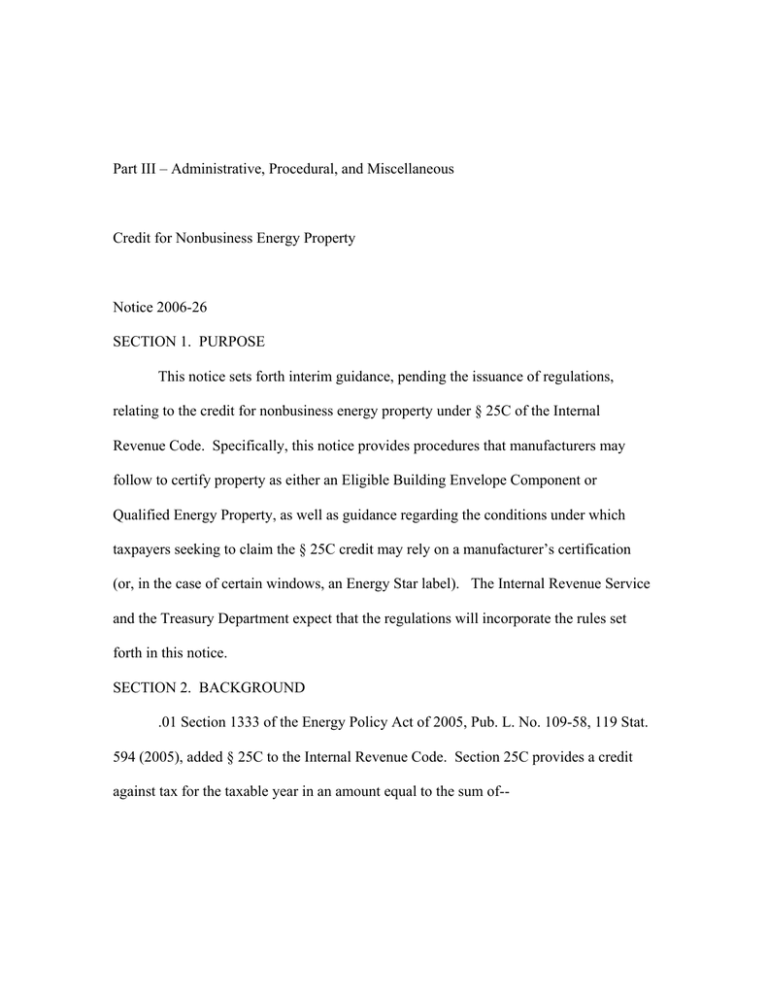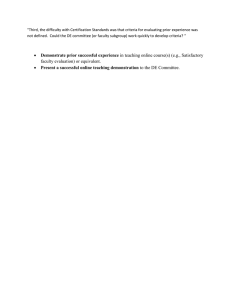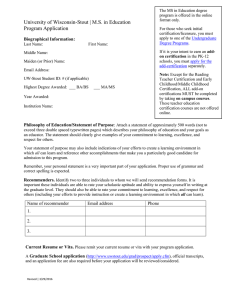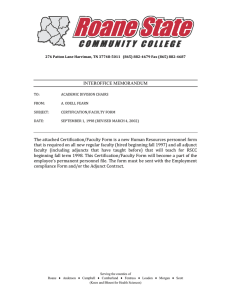Part III – Administrative, Procedural, and Miscellaneous Notice 2006-26
advertisement

Part III – Administrative, Procedural, and Miscellaneous Credit for Nonbusiness Energy Property Notice 2006-26 SECTION 1. PURPOSE This notice sets forth interim guidance, pending the issuance of regulations, relating to the credit for nonbusiness energy property under § 25C of the Internal Revenue Code. Specifically, this notice provides procedures that manufacturers may follow to certify property as either an Eligible Building Envelope Component or Qualified Energy Property, as well as guidance regarding the conditions under which taxpayers seeking to claim the § 25C credit may rely on a manufacturer’s certification (or, in the case of certain windows, an Energy Star label). The Internal Revenue Service and the Treasury Department expect that the regulations will incorporate the rules set forth in this notice. SECTION 2. BACKGROUND .01 Section 1333 of the Energy Policy Act of 2005, Pub. L. No. 109-58, 119 Stat. 594 (2005), added § 25C to the Internal Revenue Code. Section 25C provides a credit against tax for the taxable year in an amount equal to the sum of-- -2(1) Ten percent of the amount paid or incurred by the taxpayer for qualified energy efficiency improvements (that is, property described in section 4.01 of this notice) installed during the taxable year; and (2) The amount of expenditures for residential energy property (that is, property described in section 5.01 of this notice) paid or incurred by the taxpayer during the taxable year. .02 Under § 25C(b), the maximum amount of the credit allowable to a taxpayer under § 25C(a) for all taxable years is $500 ($200 in the case of amounts paid or incurred for exterior windows (including storm windows and skylights)). In addition, the maximum amount of credit allowed is-(1) $50 for any advanced main air circulating fan; (2) $150 for any qualified natural gas, propane, or oil furnace or hot water boiler; and (3) $300 for any item of energy-efficient building property (that is, property described in section 5.01(1)-(7) of this notice). .03 Section 25C(g) and § 1333(c) of the Energy Policy Act provide that the credit applies to property placed in service after December 31, 2005, and before January 1, 2008. SECTION 3. REFERENCES TO INTERNATIONAL ENERGY CONSERVATION CODE Manufacturers and taxpayers may treat any reference in this notice to the International Energy Conservation Code (IECC) as a reference to either the 2001 -3Supplement of the 2000 International Energy Conservation Code or the 2004 Supplement of the 2003 International Energy Conservation Code. SECTION 4. QUALIFIED ENERGY EFFICIENCY IMPROVEMENTS .01 Eligible Building Envelope Components. The credit for qualified energy efficiency improvements is allowed with respect to the following building envelope components (Eligible Building Envelope Components): (1) An insulation material or system (including any vapor retarder or seal to limit infiltration) that-(a) Is specifically and primarily designed (within the meaning of section 4.04 of this notice) to reduce heat loss or gain of a dwelling unit when installed in or on the dwelling unit; and (b) May be taken into account in determining whether the building thermal envelope requirements established by the IECC are satisfied; (2) An exterior window, skylight, or door (other than a storm window or storm door) that meets or exceeds the prescriptive criteria established by the IECC for the climate zone in which the window, skylight, or door is installed; (3) A storm window that, in combination with the exterior window over which it is installed, meets or exceeds the prescriptive criteria established by the IECC for the climate zone in which such storm window is installed; (4) A storm door that, in combination with a wood door assigned a default U-factor by the IECC, does not exceed the default U-factor requirement assigned to such combination by the IECC; and (5) Any metal roof that-- -4(a) Has appropriate pigmented coatings that are specifically and primarily designed to reduce the heat gain of a dwelling unit when installed on the dwelling unit; and (b) Meets or exceeds Energy Star program requirements (as in effect at the time of installation). .02 Manufacturer’s Certification. (1) Requirements Applicable to Manufacturer. The manufacturer of a building envelope component may certify to a taxpayer that the component is an Eligible Building Envelope Component by providing the taxpayer with a certification statement that satisfies the requirements of section 4.02(4) of this notice. The certification statement may be provided by including a written copy of the statement with the packaging of the component, in printable form on the manufacturer’s website, or in any other manner that will permit the taxpayer to retain the certification statement for tax recordkeeping purposes. (2) Taxpayer Reliance. Except as provided in section 4.02(3) and (6) of this notice, a taxpayer may rely on a manufacturer’s certification that a building envelope component is an Eligible Building Envelope Component. A taxpayer is not required to attach the certification statement to the return on which the credit is claimed. However, § 1.6001-1(a) of the Income Tax Regulations requires that taxpayers maintain such books and records as are sufficient to establish the entitlement to, and amount of, any credit claimed by the taxpayer. Accordingly, a taxpayer claiming a credit for an Eligible Building Envelope Component should retain the certification statement as part of the taxpayer’s records for purposes of § 1.6001-1(a). -5(3) Reliance Permitted Only for Installation Consistent with Certification. A taxpayer may rely on a manufacturer’s certification that a building envelope component is an Eligible Building Envelope Component-(a) In the case of an exterior window, skylight, or door (other than a storm window or storm door), only if the component is installed in a climate zone identified in the certification statement; and (b) In the case of a storm window, only if the component is installed over an exterior window of a class identified in the certification statement and in a climate zone identified for that class of exterior window. (4) Content of Manufacturer’s Certification Statement. A manufacturer’s certification statement must contain the following: (a) The name and address of the manufacturer; (b) Identification of the component as an insulation material or system, an exterior window or skylight, an exterior door, or a metal roof; (c) The make, model number, and any other appropriate identifiers of the component; (d) A statement that the component is an Eligible Building Envelope Component that qualifies for the credit allowed under § 25C; (e) In the case of an exterior window, skylight, or door (other than a storm window or storm door), the climate zone or zones for which the applicable prescriptive criteria are satisfied; (f) In the case of a storm window-- -6(i) The classes of exterior window (e.g., single pane; double pane, clear glass; double pane, Low-E coating) over which the storm window may be installed and that, in combination with the storm window, satisfy the applicable prescriptive criteria for one or more climate zones; and (ii) For each such class of exterior window, the climate zone or zones for which the applicable prescriptive criteria are satisfied; and (g) A declaration, signed by a person currently authorized to bind the manufacturer in such matters, in the following form: “Under penalties of perjury, I declare that I have examined this certification statement, and to the best of my knowledge and belief, the facts are true, correct, and complete.” (5) Manufacturer’s Records. A manufacturer that certifies to a taxpayer that a component is an Eligible Building Envelope Component must retain in its records documentation establishing that the component satisfies the applicable conditions of section 4.01 of this notice including, in the case of an exterior window, its National Fenestration Rating Council (NFRC) rating. The manufacturer must, upon request, make such documentation available for inspection by the Service. (6) Effect of Erroneous Certification or Failure to Satisfy Documentation Requirements. The Service may, upon examination (and after any appropriate consultation with the Department of Energy (DOE) or Environmental Protection Agency (EPA)), determine that a component that has been certified under this section is not an Eligible Building Envelope Component. In that event, or if the component’s manufacturer fails to satisfy the requirements relating to documentation in section 4.02(5) -7of this notice, the manufacturer’s right to provide a certification on which future purchasers of the component can rely will be withdrawn, and taxpayers purchasing the component after the date on which the Service publishes an announcement of the withdrawal may not rely on the manufacturer’s certification. Taxpayers may continue to rely on the certification for components purchased on or before the date on which the announcement of the withdrawal is published (including in cases in which the component is not installed and the credit is not claimed until after the announcement of the withdrawal is published). Manufacturers are reminded that an erroneous certification statement may result in the imposition of penalties-(a) Under § 7206 for fraud and making false statements; and (b) Under § 6701 for aiding and abetting an understatement of tax liability (in the amount of $1,000 per return on which a credit is claimed in reliance on the certification). (7) Availability of Certification Information. Manufacturers are encouraged to provide a listing of qualified components and applicable certification information on their websites to facilitate taxpayer identification of qualified components. .03 Special Rule for Energy Star Windows and Skylights. A taxpayer may treat an exterior window or skylight that bears an Energy Star label and is installed in the region identified on the label as an Eligible Building Envelope Component and may rely on such Energy Star label, rather than on a manufacturer’s certification statement, in claiming the § 25C credit. -8.04 Specifically and Primarily Designed. A component is not specifically and primarily designed to reduce heat loss or gain of a dwelling unit if its principal purposes are to provide structural support, to provide a finished surface, as in the case of drywall or siding, or to serve any other function unrelated to the reduction of heat loss or gain. The principal purpose of a component serves functions unrelated to the reduction of heat loss or gain if production costs attributable to features other than those that reduce heat loss or gain exceed production costs attributable to features that reduce heat loss or gain. .05 Additional Requirements. A taxpayer may claim a credit with respect to amounts paid or incurred for an Eligible Building Envelope Component only if the following additional requirements are satisfied: (1) The component is installed in or on a dwelling unit located in the United States and, at the time of installation, the dwelling unit is owned and used by the taxpayer as the taxpayer’s principal residence (within the meaning of § 121); (2) The original use of the component commences with the taxpayer; and (3) The component reasonably can be expected to remain in use for at least five years. For this purpose, a component will be treated as reasonably expected to remain in use for at least five years if the manufacturer offers, at no extra charge, at least a two-year warranty providing for repair or replacement of the component in the event of a defect in materials or workmanship. If the manufacturer does not offer such a warranty, all relevant facts and circumstances are taken into account in determining whether the component reasonably can be expected to remain in use for at least five years. .06 Installation Costs. With respect to Eligible Building Envelope Components, the credit is allowed only for amounts paid or incurred to purchase the components. The -9credit is not allowed for amounts paid or incurred for the onsite preparation, assembly, or original installation of the components. SECTION 5. RESIDENTIAL ENERGY PROPERTY .01 Qualified Energy Property. The credit for residential energy property expenditures is allowed with respect to the following property (Qualified Energy Property): (1) An electric heat pump water heater that yields an energy factor of at least 2.0 in the standard DOE test procedure; (2) An electric heat pump that has a heating seasonal performance factor (HSPF) of at least 9, a seasonal energy efficiency ratio (SEER) of at least 15, and an energy efficiency ratio (EER) of at least 13; (3) A closed loop geothermal heat pump that has an EER of at least 14.1 and a heating coefficient of performance (COP) of at least 3.3; (4) An open loop geothermal heat pump that has an EER of at least 16.2 and a heating COP of at least 3.6; (5) A direct expansion geothermal heat pump that has an EER of at least 15 and a heating COP of at least 3.5; (6) A central air conditioner that achieves the highest efficiency tier that has been established by the Consortium of Energy Efficiency and is in effect on January 1, 2006; (7) A natural gas, propane, or oil water heater that has an energy factor of at least 0.80; - 10 (8) A natural gas, propane, or oil furnace or hot water boiler that achieves an annual fuel utilization efficiency rate of not less than 95; and (9) A fan that is used in a natural gas, propane, or oil furnace and has an annual electricity use of no more than 2 percent of the total annual site energy use of the furnace (as determined in the standard DOE test procedure). .02 Manufacturer’s Certification. — (1) Requirements Applicable to Manufacturer. The manufacturer of a product may certify to a taxpayer that the product is Qualified Energy Property by providing the taxpayer with a certification statement that satisfies the requirements of section 5.02(3) of this notice. The certification statement may be provided by including a written copy of the statement with the packaging of the product, in printable form on the manufacturer’s website, or in any other manner that will permit the taxpayer to retain the certification statement for tax recordkeeping purposes. (2) Taxpayer Reliance. Except as provided in section 5.02(5) of this notice, a taxpayer may rely on a manufacturer’s certification that a product is Qualified Energy Property. A taxpayer is not required to attach the certification statement to the return on which the credit is claimed. However, § 1.6001-1(a) of the Income Tax Regulations requires that taxpayers maintain such books and records as are sufficient to establish the entitlement to, and amount of, any credit claimed by the taxpayer. Accordingly, a taxpayer claiming a credit for Qualified Energy Property should retain the certification statement as part of the taxpayer’s records for purposes of § 1.6001-1(a). - 11 (3) Content of Manufacturer’s Certification Statement. A manufacturer’s certification statement to be provided to taxpayers who purchase Qualified Energy Property must contain the following: (a) The name and address of the manufacturer; (b) The class of Qualified Energy Property (as listed in section 5.01 of this notice) in which the product is included; (c) The make, model number, and any other appropriate identifiers of the product; (d) A statement that the product is Qualified Energy Property that qualifies for the credit allowed under § 25C; and (e) A declaration, signed by a person currently authorized to bind the manufacturer in these matters, in the following form: “Under penalties of perjury, I declare that I have examined this certification statement, and to the best of my knowledge and belief, the facts presented are true, correct, and complete.” (4) Manufacturer’s Records. A manufacturer that certifies to a taxpayer that a product is Qualified Energy Property must retain in its records documentation establishing that the product satisfies the applicable conditions of section 5.01 of this notice. The manufacturer must, upon request, make such documentation available for inspection by the Service. The documentation-(a) In the case of the EER for a central air conditioner or electric heat pump, must include measurements based on published data that are the result of manufacturer tests at 95 degrees Fahrenheit and may be based on the certified data of the - 12 Air Conditioning and Refrigeration Institute that are prepared in partnership with the Consortium for Energy Efficiency; and (b) In the case of a geothermal heat pump, must be based on testing under the conditions of ARI/ISO Standard 13256-1 for Water Source Heat Pumps or ARI 870 for Direct Expansion GeoExchange Heat Pumps, as appropriate, and include evidence that water heating services have been provided through a desuperheater or integrated water heating system connected to the storage water heater tank. (5) Effect of Erroneous Certification or Failure to Satisfy Documentation Requirements. The Service may, upon examination (and after any appropriate consultation with DOE or EPA), determine that a product that has been certified under this section is not Qualified Energy Property. In that event, or if the product’s manufacturer fails to satisfy the requirements relating to documentation in section 5.02(4) of this notice, the manufacturer’s right to provide a certification on which future purchasers of the product can rely will be withdrawn, and taxpayers purchasing the product after the date on which the Service publishes an announcement of the withdrawal may not rely on the manufacturer’s certification. Taxpayers may continue to rely on the certification for products purchased on or before the date on which the announcement of the withdrawal is published (including in cases in which the product is not installed and the credit is not claimed until after the announcement of the withdrawal is published). . Manufacturers are reminded that an erroneous certification statement may result in the imposition of penalties-(a) Under § 7206 for fraud and making false statements; and - 13 (b) Under § 6701 for aiding and abetting an understatement of tax liability (in the amount of $1,000 per return on which a credit is claimed in reliance on the certification). (6) Availability of Certification Information. Manufacturers are encouraged to provide a listing of qualified products and applicable certification information on their websites to facilitate taxpayer identification of qualified products. .03 Additional Requirements. A taxpayer may claim a credit with respect to expenditures paid or incurred for Qualified Energy Property only if the following additional requirements are satisfied: (1) The property is installed on or in connection with a dwelling unit located in the United States and, at the time of installation, the dwelling unit is owned and used by the taxpayer as the taxpayer’s principal residence (within the meaning of § 121); and (2) The property is originally placed in service by the taxpayer. .04 Installation Costs. The credit is allowed for amounts paid or incurred to purchase Qualified Energy Property and for expenditures for labor costs properly allocable to the onsite preparation, assembly, or original installation of the property. SECTION 6. PAPERWORK REDUCTION ACT The collection of information contained in this notice has been reviewed and approved by the Office of Management and Budget in accordance with the Paperwork Reduction Act (44 U.S.C. 3507) under control number 1545-1989. - 14 An agency may not conduct or sponsor, and a person is not required to respond to, a collection of information unless the collection of information displays a valid OMB control number. The collections of information in this notice are in sections 4 and 5. This information is required to be collected and retained in order to ensure that property meets the requirements for the Nonbusiness Energy Credit under § 25C. This information will be used to determine whether the property for which manufacturers provide certifications is property that qualifies for the credit. The collection of information is required to obtain a benefit from manufacturers’ certification statements that property qualifies for the credit. The likely respondents are corporations, partnerships, and individuals. The estimated total annual reporting burden is 350 hours. The estimated annual burden per respondent varies from 2 hours to 3 hours, depending on individual circumstances, with an estimated average burden of 2.5 hours to complete the requests for certification required under this notice. The estimated number of respondents is 140. The estimated annual frequency of responses is on occasion. Books or records relating to a collection of information must be retained as long as their contents may become material in the administration of any Internal Revenue law. Generally, tax returns and tax return information are confidential, as required by 26 U.S.C. 6103. - 15 SECTION 7. DRAFTING INFORMATION The principal author of this notice is Kelly R. Morrison-Lee of the Office of Associate Chief Counsel (Passthroughs and Special Industries). For further information regarding this notice contact Jennifer Bernardini at (202) 622-3120 (not a toll-free call).



